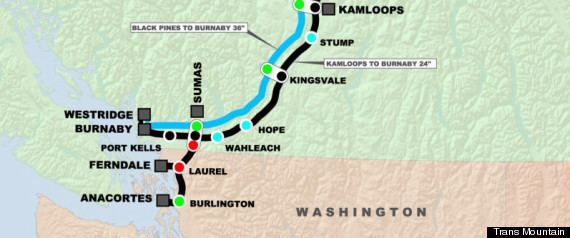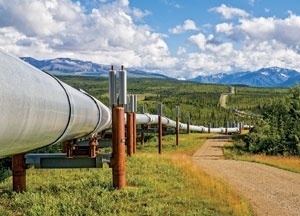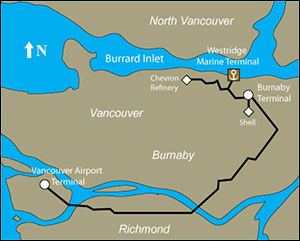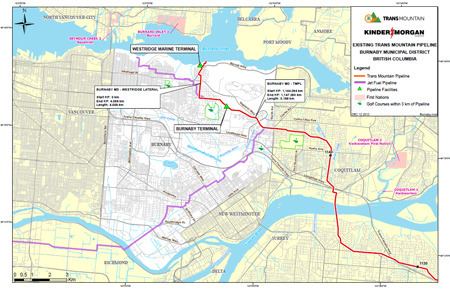Country Canada Type Oil Diameter 24 in (610 mm) Commissioned 1951 | From Edmonton, Alberta Length 1,150 km (710 mi) Owner Kinder Morgan Provinces Alberta, British Columbia | |
To Burnaby, British Columbia | ||
The Kinder Morgan Trans Mountain Pipeline System, or simply the Trans Mountain Pipeline, is a controversial oil pipeline that carries crude and refined oil from Alberta to the west coast of British Columbia. It is wholly owned by the Canadian division of Kinder Morgan and has been in use since 1953 It is the only pipeline to run between these two areas.
Contents

History

The idea for a pipeline from Alberta to British Columbia, (BC), quickly emerged after the discovery of large oil deposits around Leduc. This was driven by the growing demand for oil both in Asia and on the west coast of Canada and the United States. The US military was also interested in developing this infrastructure so that oil could more easily be accessed for military use, specifically because of the ongoing Korean War.

On March 21, 1951, the Trans Mountain Pipeline Company was created by a special act of parliament. On the same day, the company made a pipeline proposal to the Board of Transport Commissioners. Ownership of the company was split between Canadian Bechtel Ltd. and Standard Oil.

After approval, construction of the pipeline began in February 1952. Canadian Bechtel Ltd. was responsible for the engineering, design, and construction of the project.
On October 17, 1953, oil began to be pumped through the pipeline, which had cost $93 million.
In 2004, Kinder Morgan began the process to add a second pipe, running parallel to the first, for the portion of the pipeline running between Hinton, Alberta, and Hargreaves, British Columbia. The addition required two more pumping stations, which are the Wolf Pump Station, near Niton Junction, Alberta, and the Chappel Pump Station, near Pyramid, British Columbia. The project was completed in 2008, increasing capacity by 40,000 barrels per day (6,400 m3/d), (from 260,000 to 300,000 barrels per day (41,000 to 48,000 m3/d)).
Expansion project

In 2013, Kinder Morgan filed an application to the Canadian National Energy Board for building a second pipeline under the Trans Mountain Pipeline Expansion Project. The second pipeline was to run roughly parallel to the existing pipeline, between Edmonton and Burnaby, (east of Vancouver), and to be used to transport diluted bitumen. The additional pipeline requires 12 new pumping stations. The proposed expansion, with 980 kilometres (610 mi) of pipe, would increase the system's capacity from 300,000 barrels a day to 890,000. This increase would help supply growing demand in the United States, and specifically in Asia. An investment of $6.8 billion would complete the connection between Strathcona County, Alberta, and Burnaby, British Columbia.
Kinder Morgan had the support of several large petroleum industry customers for this expansion, (BP Canada Energy Trading Co., Canadian Natural Resources, Canadian Oil Sands Ltd., Cenovus Energy Inc., Devon Canada Corp., Husky Energy Marketing Inc., Imperial Oil Ltd., Nexen Marketing Inc., Statoil Canada Ltd., Suncor Energy Marketing Inc., Suncor Energy Products Partnership, Tesoro Refining & Marketing Co. and Total E&P Canada Ltd).
In 2016, BC said that it did not support Trans Mountain, partly because Kinder Morgan has not provided enough information about its proposed spill prevention program.
On November 29, 2016, Canada's federal cabinet approved the expansion project, announcing that the approval was "subject to 157 binding conditions that will address potential Indigenous, socio-economic and environmental impacts, including project engineering, safety and emergency preparedness. This $6.8-billion project will create 15,000 new jobs during construction."
Even after government approval, "it is going to be a struggle for Kinder Morgan, say industry, environmental and political observers and players." Seven Federal Court challenges have been filed by the municipalities of Vancouver and Burnaby, and the Tsleil-Waututh, Suquamish, Kwantlen, and Coldwater First Nations.
Debate
Controversy surrounding the Trans Mountain Pipeline stems from the fact that in the past Kinder Morgan has had 82 reported spills and other environmental accidents surrounding the already-existing pipeline, including:
A study by Simon Fraser University claims that Kinder Morgan has overestimated the economic benefits of the pipeline expansion. This report directly contradicts the narrowing of the WTI and Brent futures index after Obama similarly opened the US domestic market to foreign exports.
The existing and proposed pipelines ship diluted bitumen through the Strait of Juan de Fuca, an extremely sensitive environmental region. The tankers have to pass through a very narrow channel of shallow water to reach the open sea, making the project controversial and strongly opposed by some Canadians [1] and Americans, for reasons similar to the opposition to Keystone XL, Line 9, and Northern Gateway and offshore deep ocean oil drilling.
Protests
The expansion project faced strong opposition from civic governments, First Nations, environmentally concerned citizens, and others. Protests in November 2014 focused on Kinder Morgan's surveying work.
Members of the Squamish and Tsleil-Waututh First Nations of British Columbia paddled canoes on the waters of Burrard Inlet to the Kinder Morgan Burnaby Terminal for a ceremony to protest the expansion of the Trans Mountain pipeline, in North Vancouver, B.C., on September 1, 2012. Tsleil-Waututh leaders hoped to shut down the project altogether. Many of these pipelines also pass through the Strait of Juan de Fuca, which is an extremely sensitive region. The British Columbian Government is also opposed to the Trans Mountain Pipeline, as Kinder Morgan did not provide enough information on their spill prevention program. On November 29, 2016, the project was approved by the federal government.
Those who support the pipeline say that it will create jobs and that it has a lower risk of spilling oil then transporting oil by rail, which pipeline proponents say would otherwise have to be used.
Other projects
The pipeline is part of multiple projects to increase the export of Canadian oil to international markets, as well as to Eastern Canada and to refineries around North America. Other projects include the Northern Gateway Pipeline from Alberta to Kitimat, the Keystone XL Pipeline to the Southern US, and Line 9 and Energy East to eastern provinces.
